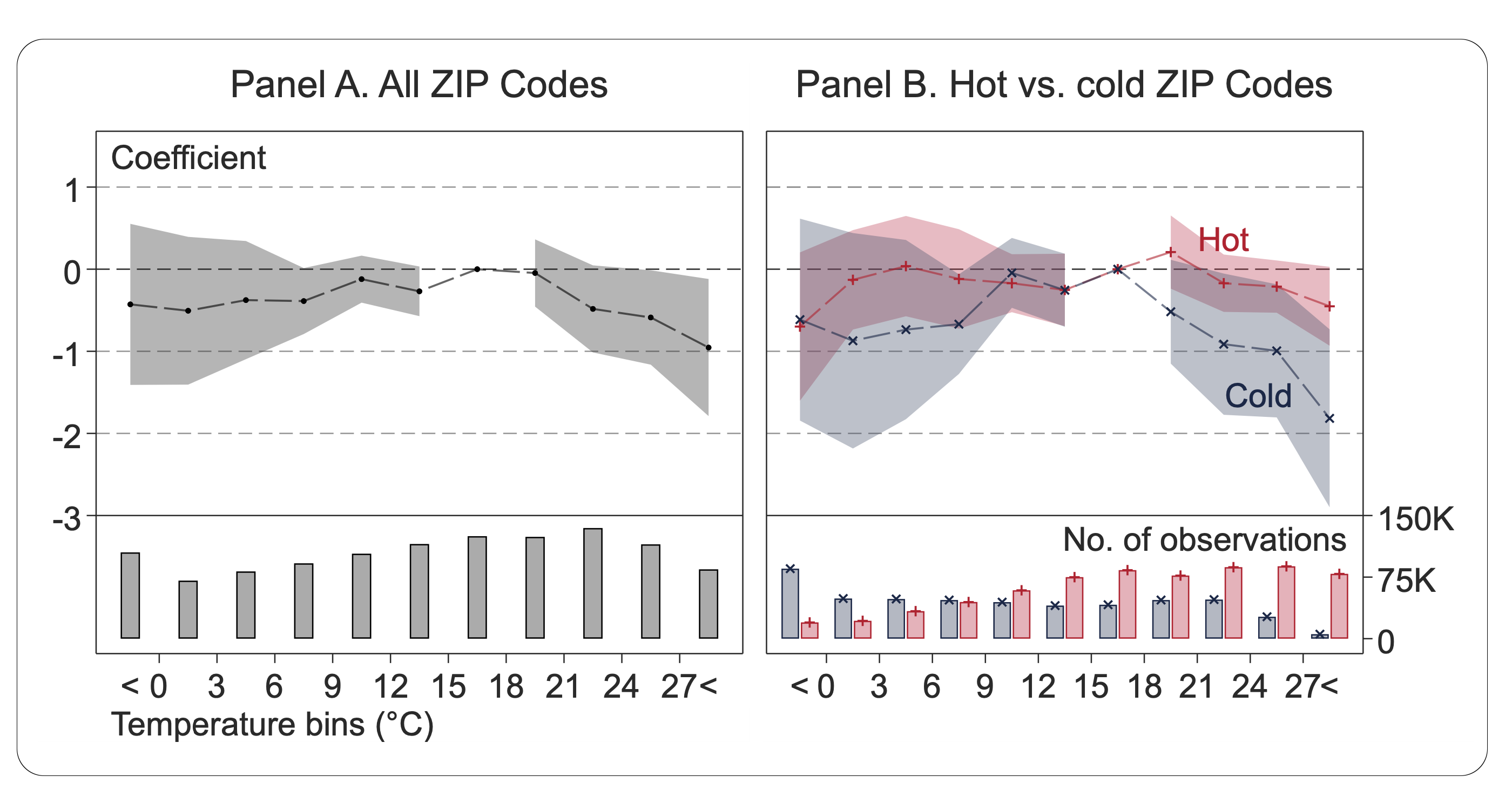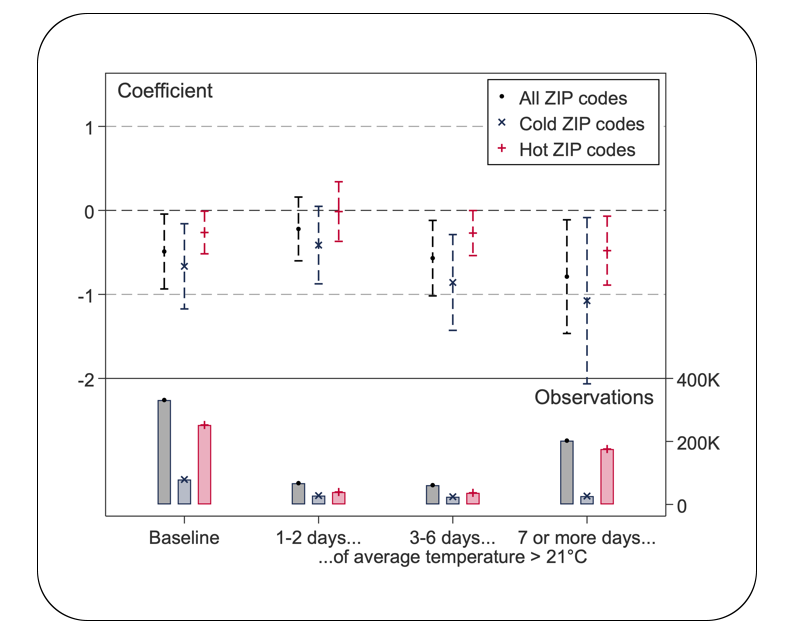CEEPR Working Paper
2022-019, December 2022
Benjamin Krebs
Boston suffered from a tremendous heat wave this summer. Both in July and August temperatures rose beyond 90°F (32°C) for six consecutive days. The city declared a heat emergency and advised citizens to stay indoors. Temperatures above 90°F are a severe threat to human health. Extended exposure may lead to cardiovascular problems, or even death. Disconcertingly, climate change models predict such heat waves to become more frequent and to last over longer periods of time.
Emergency admissions and heat fatalities are an extreme outcome of heat waves and, fortunately, a relatively small share of U.S. residents experiences them. But hot temperatures affect humans in other, more subtle dimensions, which are less severe but affect a broader population. One example is cognitive performance, which is central to any human activity, an input to our labor productivity, and vital in our everyday lives. It is, therefore, essential to understand how temperature impacts cognitive performance, and how climate change affects this relationship.
In this paper I estimate the effect of temperature on cognitive performance using data from an online mental arithmetic training game called Raindrops, played on the Lumosity platform. The dataset I use contains more than 31,000 residents from the contiguous United States, who played 1.15 million times in total. I know approximately where and when people used the software. That allows me to match their performance with weather data from the National Centers for Environmental Information surface database. I run regression analyses with the average temperature during the 24 hours preceding a play as the main explanatory variable.
Mental arithmetic performance not only depends on temperature but also on many other things. Indeed, in my data people living in colder regions of the country perform better on average than people living in hotter regions. This might be due to factors that are completely independent of the weather. To account for that, I subtract each individual’s mean performance from their scores – I run what economists call fixed-effects regressions. This essentially amounts to comparing the individuals to themselves under different temperature exposures, instead of comparing people to each other. This is possible due to the data structure, where I observe each individual many times. In the regression analyses I further control for a variety of play characteristics and weather variables.
The results in Panel A of Figure 1 show that people do experience a performance drop when temperatures are high. The points represent the coefficients from the regression on different temperature bins and the gray area depicts the confidence interval. Relative to the optimal temperature of around 16.5°C (62°F), players score about 0.48 (0.7%) fewer points when temperatures are between 21 and 24°C (70-75°F), and about 0.95 (1.5%) fewer points when they are above 27°C (81°F). I do not observe any statistically significant effects for cold temperatures.
 |
Figure 1. Air temperature and cognitive performance: 3°C-bins regressions. |
There is an important heterogeneity in these results: Panel B of Figure 1 shows that people living in colder regions seem to respond much more to high temperatures. Their score decreases by 1.82 (2.7%) on days above 27°C (81°F), while the score of people living in hotter regions only drops by 0.45 (0.7%). This points to the role of adaptation. As hotter regions experience such temperatures more frequently, they are better equipped to attenuate their consequences. For example, in places that are hotter on average, a higher share of households has air conditioning.
Consequently, as temperatures rise, one should expect an increase in air conditioning in colder places. Does that mean that heat waves will be less of a problem in the future due to this adaptation? Unfortunately, climate change not only leads to adaptation but also to intensification. Heat waves will become even hotter and stretch over more consecutive days. Figure 2 shows that, if average temperatures are above 21°C (70°F) for multiple days, the effect gets worse. While the performance drop in hotter regions is still smaller than in colder regions, the effect nonetheless increases with the number of consecutive hot days. Thus, climate change will probably worsen the effect even in well-adapted regions.
 |
Figure 2. Effect accumulation.
Notes: Coefficients with 95% confidence intervals (left y-axis), and number of observations (right y-axis) from regressions of the number of correct answers on and indicator = 1 if the average temperature was above 21°C during different temporal periods before a play (x-axis). The standard errors are clustered on ZIP Codes. The baseline is 24 hours preceding a play. The reference is a day with an average temperature below or exactly 21°C. I run separate regressions for all observations, the cold-ZIP Codes sample (below-median 2015-2019 average temperatures), and the hot-ZIP Codes sample (above-median 2015-2019 average temperatures). The control variables include individual effects, time effects, play controls, and weather controls |
My research is part of a growing literature that addresses the social and economic consequences of climate change. In the realm of cognitive impairments, a couple of papers have analyzed how temperature affects adolescents during important exams (e.g., Graff Zivin et al., 2020; Park et al., 2020; Park, 2022). While understanding the role of environmental factors in this context is highly relevant, individuals are potentially much more sensitive to these factors when they find themselves in this particularly stressful, non-everyday situation. My study complements these findings. I investigate temperature impacts in a familiar environment, representative of everyday situations. This context gives insight into how temperature affects us all on a daily basis.
References
Graff Zivin, Joshua, Yingquan Song, Qu Tang, and Peng Zhang (2020). Temperature and high-stakes cognitive performance: Evidence from the national college entrance examination in China. Journal of Environmental Economics and Management 104, 102365.
Krebs, Benjamin (2022). Temperature and Cognitive Performance. MIT CEEPR Working Paper 2022-019, December 2022.
Park, R. Jisung, Joshua Goodman, Michael Hurwitz, and Jonathan Smith (2020). Heat and learning. American Economic Journal: Economic Policy 12(2), 306–339.
Park, R. Jisung (2022). Hot temperature and high-stakes performance. Journal of Human Resources 57(2), 400–434.



